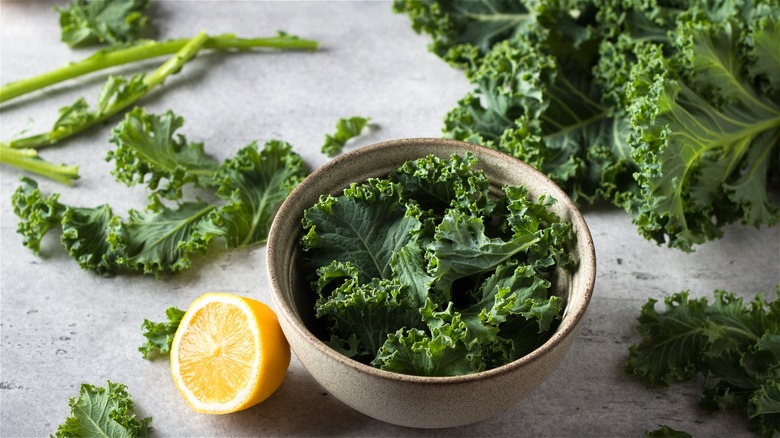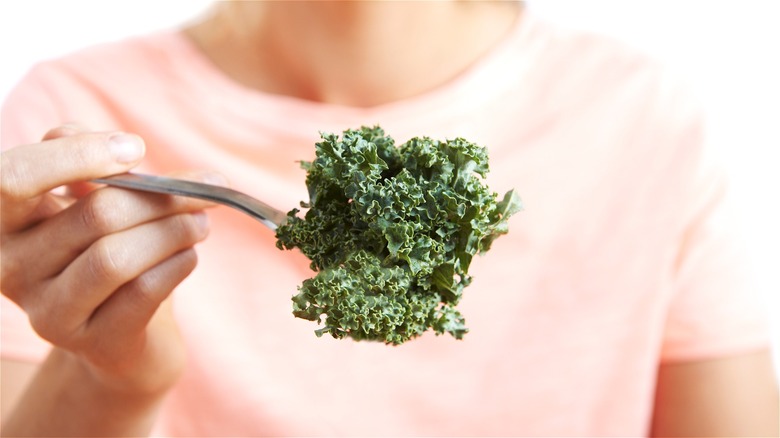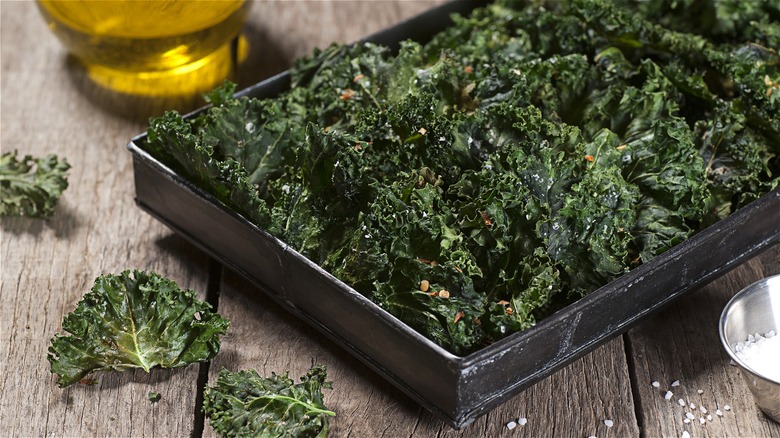Should You Eat Raw Kale?
Among the list of 12 protein-packed vegetables and how to cook them, kale is one highly nutritious vegetable that is frequently consumed without any sauteeing, steaming, or roasting. For many salad lovers, a perfectly massaged bed of chopped kale in tangy vinaigrette makes the perfect base for one convenient yet satisfying meal. Next to the flavor and versatility of this leafy green vegetable, raw kale also packs quite a nutritious punch. Besides being high in protein, Healthline claims kale is loaded with important antioxidants such as Vitamins C and K, yet also touts health-purporting properties that may help lower cholesterol and serve as a barrier of sorts against certain cancer cells. However, despite these positive side effects, is there a limit to how much raw kale a person can and should consume?
Since kale is considered a cruciferous vegetable, its high fiber content may be hard on your stomach when consumed raw. Luckily, if you decide to cook kale first, you're not necessarily losing all nutritional value. According to the Food Revolution Network, raw kale may contain more vitamin C, yet steaming or roasting this nutritious green indirectly increases your consumption of vitamins A and K. Besides an occasional upset stomach, you might be curious to know if consuming considerable amounts of raw kale poses any additional health concerns.
The downside to raw kale consumption
Especially if you enjoy consuming salads all year round, like your signature winter kale salad with pistachios, kumquats, and ricotta cheese, the last thing you want to discover is that your favorite salad base may pose health concerns. However, eating large quantities of raw kale only affects a small sect of individuals who typically struggle with a thyroid-related health condition.
Kale is rich in more than a handful of vitamins and minerals, and what makes this leafy green extra powerful in fighting cancer and specific radicals is this veggie's production of sulforaphane. While Body Ecology claims sulforaphane has many positive attributes, this chemical also produces goitrogens, which are antinutrients that prevent the thyroid from properly absorbing iodine. If you suffer from either an iodine deficiency or a pre-existing condition such as hypothyroidism, eating too much raw kale may cause increased and abnormal cell growth or goiter in and around the thyroid. This can lead to a depletion of energy, dry skin, and a slowing effect on your metabolism.
Luckily, you can deactivate those pesky goitrogens by cooking kale in various ways and maintaining an extensive diet laden with a number of different vegetables. Additionally, according to the Mayo Clinic, even if you have a pre-existing thyroid condition, you would have to eat substantially large amounts of kale every single day for this veggie's antinutrients to negatively impact the body.
Is there a limit to how much kale you can eat every day?
If you simply can't get enough of your usual kale, mango, and avocado salad and want to ensure you're not overdoing it, you don't have to worry too much about overconsumption. The USDA MyPlate vegetable recommendations for adult males and females range from 2-4 cups of assorted varieties. The only thing to pay attention to when it comes to dark leafy greens is the fact that two cups of raw greens, such as broccoli, spinach, and kale, count as just one cup of your daily amount. However, if you cook these vegetables, one cup of cooked leafy greens equals one cup of your daily vegetables.
As long as you continue to incorporate other healthy veggies into your diet, you can eat kale whenever you desire, though some people do need to watch how much raw kale they intake. If you eat raw kale fairly often, Emc Healthcare suggests paying attention to how you feel post-consumption. Large amounts of raw cruciferous vegetables may potentially cause stomach upset due to the fibrous content of these foods. Next to digestibility concerns, people at a higher risk of developing kidney stones or absorbing iodine should also be cautious about how much raw kale they consume daily. While an average adult with little health concerns can eat three cups of raw kale daily and feel fine, you might wonder if pre-cooking kale outweighs any notable concerns.
How to safely incorporate more kale into your diet
While there certainly isn't anything wrong with eating your fair share of raw kale, you may want to cook it from time to time to not only give your stomach a break but also to add more complexity to your diet. Even though cooking kale will eliminate any goitrogens or tummy troubles, Healthline claims cooking raw kale will impact the nutritional composition of your leafy greens and lead to some degree of nutrient loss. One 2018 study published in the "International Journal of Food Sciences and Nutrition" found steaming resulted in less nutrient loss when compared to other cooking methods.
Regardless of whether you prefer raw or cooked kale, you need to strive to incorporate both varieties into your diet to give your body a well-rounded mix of different vitamins and varied degrees of easily digestible foods. Besides chowing down on another kale salad, why not make a crispy pan of easy baked kale chips? Among the many different ways you can prepare kale, next to roasting and massaging with your favorite salad dressing, you can turn kale into a delicious side dish with a bit of olive oil and chopped garlic or in a warming pot of white bean and kale soup with sausage. You truly can enjoy kale however you choose. While the outlined health concerns detailed above are worth considering, activating any predisposed health conditions occurs only when you consume considerably large amounts of raw kale daily.



